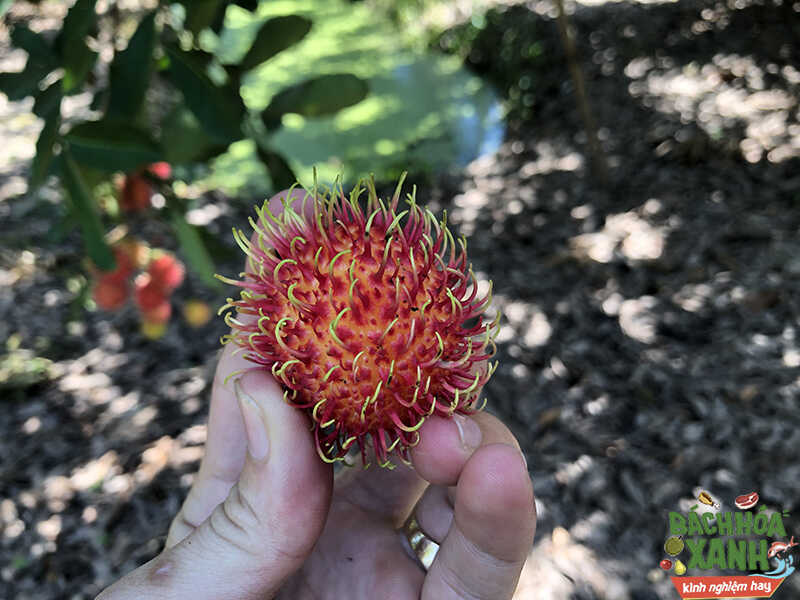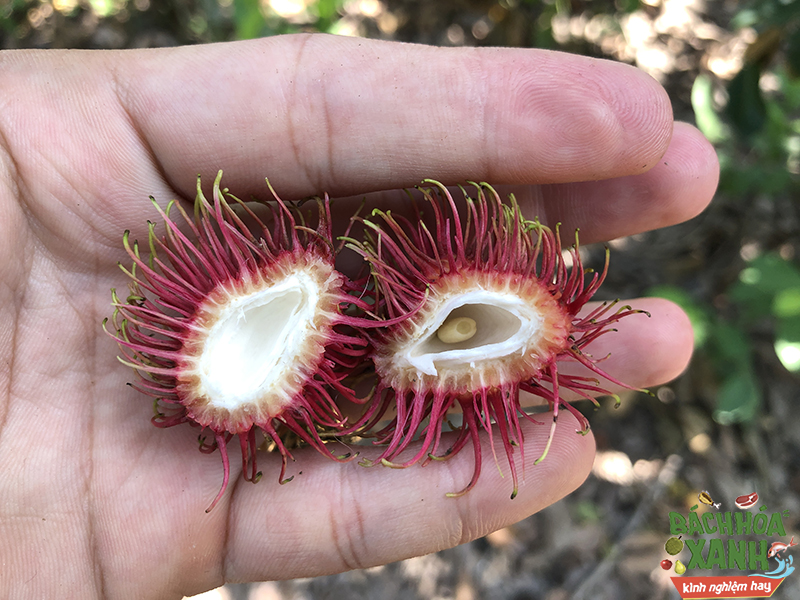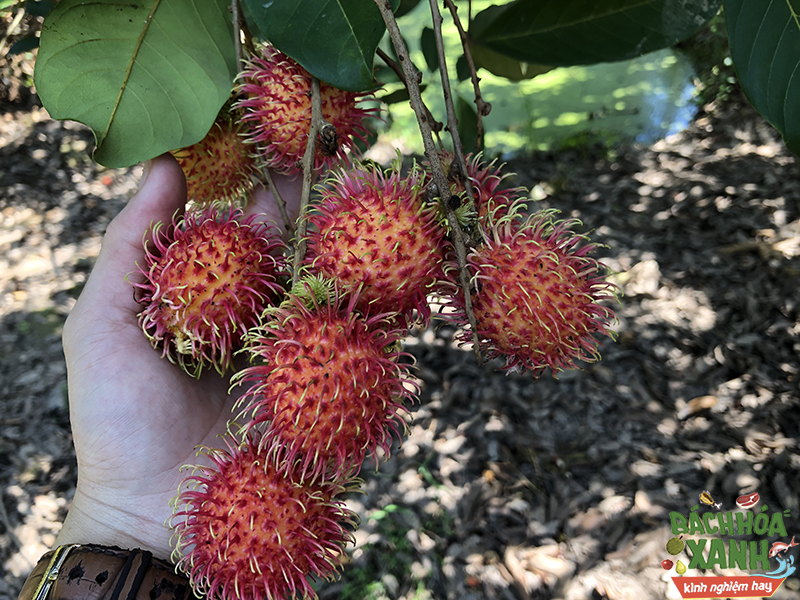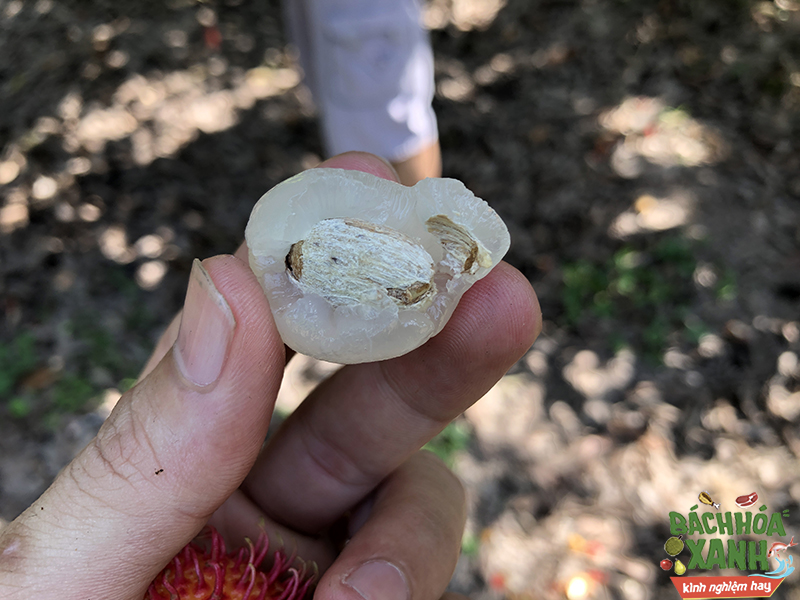With the naked eye, carefully observe a bunch of rambutan to assess its quality before purchasing:
1 Examine the Spiny Shell
Fresh rambutan fruits have crisp shells; when pressed, they should not feel soft, mushy, or release any water. The spines should also be crisp with slightly green or bright red tips.
 Examining the Spiny Shell
Examining the Spiny Shell
Avoid fruits with soft shells that have turned dark; their spines may also appear wilted or have turned dark and resemble the shell. Such fruits are likely old, wilted, and have tough, unappetizing flesh. Also, refrain from choosing red rambutan fruits that are not round, as they tend to be hollow and lack a seed.

2 Observe the Leaves on the Bunch
– Freshly picked or ripe rambutan bunches will have green leaves, and the young fruits will also be green and fresh. Choosing this type ensures freshness and flavor.

– If the leaves appear wilted, dry, or black, and the young fruits on the bunch are also dry and dark, the rambutan is likely old and wilted.
3 Inspect the Aril
– Delicious rambutan arils are opaque white, appear juicy, and have a distinctive aroma.

[captionnews]Delicious rambutan arils are opaque white and firm, with a juicy appearance[/captionnews]
– If the aril is yellowish, oozes water when peeled, or has an unusual odor, the rambutan is likely overripe, spoiled, or past its prime, and will not provide the desired crispness and ease of peeling.
4 Avoid Yellow Fruits

Yellow rambutan indicates that it is just ripe and may not be sweet, often carrying a sour taste.
5 Taste Test
While rambutan may appear fresh and enticing, with aromatic arils, it is best to taste a fruit to ensure its sweetness and quality. Pick a random fruit from a random bunch and give it a try to test its freshness, crispness, and sweetness.
6 Choose Rambutan by Type
– Rambutan Nhãn: Select fruits with shells that are yellow, turning red towards the top (2/3 red). Look for fresh spines and shells. Ripe Nhãn rambutan is firm, with crisp, short, and evenly distributed spines, and it does not release water when peeled.
– Thai Rambutan: Choose fruits that are red with a hint of yellow, with hard spines that are slightly green or pinkish at the tips. The shell should be crisp, and there should be little to no honey oozing out when peeled, indicating optimal ripeness, and making the flesh easy to remove and delicious.
– Rambutan Tróc: This variety is usually at its best when the fruits are fresh and red with a hint of yellow. The spines should be crisp and abundant, with green tips. When peeled, the shell should not release honey or water, ensuring a crisp and easy-to-peel fruit.
For more information on the different types of rambutan, refer to the following article:
Rambutan is in season and tastes best when freshly picked or a few days old. So, keep these small tips in mind to choose the best rambutan, ensuring a delightful experience with juicy, easy-to-peel fruits for your family!
Explore the Variety of Rambutan: Health Benefits and Preparation Tips
Have you ever wondered about the health benefits of including rambutan in your diet? Do you know what types of vitamins and minerals are present in this exotic fruit? Are you curious about various ways to prepare rambutan? If so, then read on to discover everything you need to know about rambutan and its various benefits for your health.
Rambutan: Pro Tips to Maintain That Crisp, Sweet Bite’>The Ultimate Guide to Storing Rambutan: Pro Tips to Maintain That Crisp, Sweet Bite
“Chôm chôm is a delicious and refreshing summer fruit that is loved by both adults and children alike. The following article will guide you in choosing the best-tasting chôm chôm and provide tips on how to properly store them. With this knowledge, you can enjoy this tasty treat to the fullest and impress your family and friends with your expertise.”
“How to Spot the Difference Between Real and Fake Dried Shrimp”
Dried shrimp is considered a luxury item with a price tag of almost VND 660,000 per kilogram. However, many unscrupulous traders have been using cheap chemicals to treat the shrimp and rip off unsuspecting consumers. To ensure you don’t fall prey to these deceptive practices, we will guide you on how to distinguish between the authentic and chemically-treated dried shrimp.


































